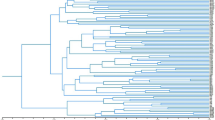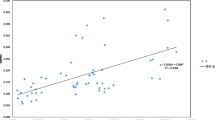Abstract
DNA sequences from the ITS region of the nuclear genome and Inter-Simple Sequence Repeat markers (ISSR) were used to estimate genetic diversity among and within populations of the Frankincense tree Boswellia sacra from Dhofar, Oman. This is a culturally and ecologically relevant species that is showing symptoms of decline due to anthropic factors and, possibly, global warming. ITS sequences were 511 bp long and showed low (6.4%) variation among geographically different populations. The four selected ISSR primers yielded 93 reproducible bands, of which 91 (97.9%) were polymorphic in the 97 individual profiles obtained. Total genetic diversity (H T) and average heterozygosity within populations (H S) resulted fairly low (0.22 and 0.136, respectively). The accession from Wadi Dowkah, an UNESCO world heritage site, showed the lowest level of genetic diversity (H E = 0.107), while the eastern populations from the Hasik area harboured a slightly greater amount of variation. Analysis of Molecular Variance showed that differentiation among populations was relatively high (38.1%), possibly due to the reduced gene flow between the largely isolated stands of Boswellia (N m = 0.39). Genetic distances and AMOVA suggested a clear differentiation between the eastern and western coastal populations, while those from the internal area did not form a consistent group. For conservation, the eastern sites should be given priority as core populations harbouring significant amounts of allelic diversity. Reasons for reinforcing the more depauperated stands, such as Wadi Dowkah, with local plant material only or, alternatively, with the introduction of germplasm from genetically distinct stands are discussed.



Similar content being viewed by others
References
Avanzini A (2000) Il porto di Sumharam nel Dhufâr. In: De Maigret A (ed) Yemen, nel paese della Regina di Saba. Skira, Milano, pp 231–233
Becerra JX, Venable DL (1999) Nuclear ribosomal DNA phylogeny and its implications for evolutionary trends in Mexican Bursera (Burseraceae). Am J Bot 86:1047–1057
Bhat KV, Babrekar PP, Lakhanpaul S (1999) Study of genetic diversity in Indian and exotic sesame (Sesamum indicum L.) germplasm using random amplified polymorphic DNA (RAPD) markers. Euphytica 110:21–33
Borchsenius F (2007) FastGap 1.0.8. Software distributed by the author (http://192.38.46.42/aubot/fb/FastGap_home.htm)
Bornet B, Branchard M (2001) Nonanchored inter simple sequence repeat (ISSR) markers: reproducible and specific tools for genome fingerprinting. Plant Mol Biol Rep 19:209–215
Corpet F (1988) Multiple sequence alignment with hierarchical clustering. Nucleic Acid Res 16:10881–10890
El Quassani AS (1984) Dhofar the land of Frankincense. International Printing Press, Ruwi
Excoffier L, Smouse PE, Quattro M (1992) Analysis of molecular variance inferred from metric distances among DNA Haplotypes: application to human mitochondrial DNA restriction data. Genetics 131:479–491
Felsenstein J (1985) Confidence limits on phylogenies: an approach using the bootstrap. Evolution 39:783–791
Feyissa T, Nybom H, Bartish IV, Welander M (2007) Analysis of genetic diversity in the endangered tropical tree species Hagenia abyssinica using ISSR markers. Genet Resour Crop Evol 54:947–958
Fleishman E, Launer AE, Switky KR, Yandell U, Heywood J, Murphy DD (2001) Rules and exceptions in conservation genetics: genetic assessment of the endangered plant Cordylanthus palmatus and its implications for management planning. Biol Conserv 98:45–53
Frankel OH, Brown AHD, Burdon JJ (1995) The conservation of plant biodiversity. Cambridge University Press, Cambridge
Ge XJ, Yu Y, Yuan Y, Huang H, Yan C (2005a) Genetic diversity and geographic differentiation in endangered Ammopiptanthus (Leguminosae) populations in desert regions of northwest China as revealed by ISSR analysis. Ann Bot 95:843–851
Ge XJ, Zhang LB, Yuan YM, Hao G, Chiang TY (2005b) Strong genetic differentiation of the East-Himalayan Megacodon stylophorus (Gentianaceae) detected by inter-simple sequence repeats (ISSR). Biodivers Conserv 14:849–861
Ghazanfar SA (1994) Handbook of Arabian medicinal plants. CRC Press, Boca Raton
Groom N (2000) I profumi d’Arabia. In: De Maigret A (ed) Yemen, nel paese della Regina di Saba. Skira, Milano, pp 87–89
Hammer K, Gebauer J, Al Khanjari S, Buerkert A (2009) Oman at the cross-roads of inter-regional exchange of cultivated plants. Genet Resour Crop Evol 56:547–560
Hamrick JL, Godt MJW (1989) Allozyme diversity in plant species. In: Brown AHD, Clegg MT, Kahler AL, Weir BS (eds) Plant population genetics, breeding and genetic resources. Sinauer, Sunderland MA, pp 43–63
Hatcher PE, Wilkinson MJ, Albani MC, Hebbern CA (2004) Conserving marginal populations of the food plant (Impatiens noli-tangere) of an endangered moth (Eustroma reticulatum) in a changing climate. Biol Conserv 116:305–317
Hedrén M (2004) Species delimitation and the partitioning of genetic diversity – an example from the Carex flava complex (Cyperaceae). Biodivers Conserv 13:293–316
Holsinger KE, Gottlieb LK (1991) Conservation of rare and endangered plants: principle and prospect. In: Falk DA, Holsinger KE (eds) Genetics and conservation of rare plants. Oxford University Press, New York, pp 195–298
Huenneke LF (1991) Ecological implications of genetic variations in plant populations. In: Falk DA, Holsinger KE (eds) Genetics and conservation of rare plants. Oxford University Press, New York, pp 31–44
Kumar S, Tamura K, Nei M (2004) MEGA3: integrated software for molecular evolutionary genetics analysis and sequence alignment. Brief Bioinform 5:150–163
Li J, Jin Z (2007) Genetic variation and differentiation in Torreya jackii Chun, an endangered plant endemic to China. Plant Sci 172:1048–1053
Lowe A, Harris S, Ashton P (2004) Ecological genetics. Design, analysis, and application. Blackwell, Oxford
Luo X, Zhuang X, Yang Y (2007) Genetic diversity of Camellia changii Ye (Theaceae) using ISSR markers. J Trop Subtrop Bot 15(2):93–100
Mantel N (1967) The detection of disease clustering and a generalized regression approach. Cancer Res 27:209–220
Meloni M, Perini D, Filigheddu R, Binelli G (2006) Genetic variation in five mediterranean populations of Juniperus phoenicea as revealed by inter-simple sequence repeat (ISSR) markers. Ann Bot 97:299–304
Mengoni A, Selvi F, Cusimano N, Galardi F, Gonnelli C (2006) Genetic diversity inferred from AFLP fingerprinting in populations of Onosma echioides (Boraginaceae) from serpentine and calcareous soils. Plant Biosyst 140:211–782
Nei M (1978) Estimation of average heterozygosity and genetic distance from a small number of individuals. Genetics 89:583–590
Nybom H (2004) Comparison of different nuclear DNA markers for estimating intraspecific genetic diversity in plants. Mol Ecol 13:1143–1155
Nybom H, Bartish I (2000) Effects of life history traits and sampling strategies on genetic diversity estimates obtained with RAPD markers in plants. Perspect Plant Ecol Evol Syst 3(2):93–114
Okun DO, Kenya EU, Oballa PO, Odee DW, Muluvi GM (2008) Analysis of genetic diversity in Eucalyptus grandis (Hill ex Maiden) seed sources using inter simple sequence repeats (ISSR) molecular markers. Afr J Biotechnol 7(13):2119–2123
Pérez-Collazos E, Catalán P (2007) Genetic diversity analysis and conservation implications for the Iberian threatened populations of the irano-turanian relict Krascheninnikovia ceratoides (Chenopodiaceae). Biol J Linn Soc 92:419–429
Raffaelli M, Tardelli M (2007) L’incenso tra mito e realtà. Produzione, commercio e raccolta della resina, ieri e oggi. Le specie di Boswellia (Burseraceae) conosciute. Conservazione delle piante in natura. Centro Studi Erbario Tropicale, Università di Firenze. Pubbl. no. 108, Firenze
Raffaelli M, Mosti S, Tardelli M (2003a) The Frankincense Tree (Boswellia sacra Flueck., Burseraceae) in Dhofar, southern Oman: field-investigations on the natural populations. Webbia 58(1):133–149
Raffaelli M, Tardelli M, Mosti S (2003b) The Wadi Doka Frankincense Park in Dhofar, Oman – first steps towards the safeguard and improvement of Boswellia sacra (Burseraceae). Pubbl. Erbario Tropicale di Firenze no. 93, Firenze
Raffaelli M, Mosti M, Tardelli M (2006) Boswellia sacra Flueck. (Burseraceae) in the Hasik area (eastern Dhofar, Oman) and a list of the surrounding flora. Webbia 61(2):245–251
Raffaelli M, Tardelli M, Mosti S (2008) Preserving and restoring the frankincense tree (Boswellia sacra) at Wadi Doka: a work in progress. In Avanzini A. (Ed.), A port in Arabia between Rome and the Indian Ocean (3rd C. BC–5th C. AD), Khor Rori Report 2. “L’Erma” di Breitschneider. Roma, pp 715–723
Rakoczy-Trojanowska M, Bolibok H (2004) Characteristics and comparison of three classes of microsatellite-based markers and their application in plants. Cell Mol Biol Lett 9:221–238
Reddy MP, Sarla N, Siddiq EA (2002) Inter simple sequence repeat (ISSR) polymorphism and its application in plant breeding. Euphytica 128:9–17
Rees AR (1995) Frankincense and Myrrh. New Plantsman 2(1):55–59
Richards CM (2000) Inbreeding depression and genetic rescue in a plant metapopulation. Am Nat 155:383–827
Rieseberg LH (1996) Homology among RAPD fragments in interspecific comparisons. Mol Ecol 5:99–105
Rohlf FJ (1990) NTSYS-pc. Numerical taxonomy and multivariate analysis system. Version 2.02. Exeter, New York
Saitou N, Nei M (1987) The neighbour-joining method: a new method for reconstructing phylogenetic trees. Mol Biol Evol 4:406–425
Schneider S, Rosselli D, Excoffier L (2000) Arlequin: a software for population genetics data analysis. Version 2.000. University of Geneva
Sica M, Gamba G, Montieri S, Gaudio L, Aceto S (2005) ISSR markers show differentiation among Italian populations of Asparagus acutifolius L. BMC Genet 6:17
Simmons MP, Ochoterena H (2000) Gaps as characters in sequence-based phylogenetic analyses. Syst Biol 49:369–381
Slatkin M (1995) A measure of population subdivision based on microsatellite allele frequencies. Genetics 139:457–462
Swofford DL (1998) PAUP*. Phylogenetic analysis using parsimony (and other methods) vers. 4.0. Sinauer, Sunderland
Thulin M, Warfa AM (1987) The Frankincense trees (Boswellia ssp., Burseaceae) of Northern Somalia and Southern Arabia. Kew Bull 42(3):487–500
Weising K, Nybom H, Wolf K, Kahl G (2005) DNA fingerprinting in plants: principles, methods and applications. CRC Press, Boca Raton
White TJ, Bruns T, Lee S, Taylor J (1990) Amplification and direct sequencing of fungal ribosomal RNA genes for phylogenetics. In: Innis MA, Gelfand DH, Shinsky JJ, White TJ (eds) PCR protocols: a guide to methods and applications. Academic Press, San Diego, pp 315–322
Xia T, Chen S, Chen S, Zhang D, Zhang D, Gao Q, Ge X (2007) ISSR analysis of genetic diversity of the Qinghai-Tibet Plateau endemic Rhodiola chrysanthemifolia (Crassulaceae). Biochem Syst Ecol 35:209–221
Xiao M, Li Q, Wang L, Guo L, Li J, Tang L, Chen F (2006) ISSR analysis of the genetic diversity of the endangered species Sinopodophyllum hexandrum (Royle) Ying from Western Sichuan Province, China. J Integr Plant Biol 48(10):1140–1146
Acknowledgments
The authors wish to acknowedge the Office for Cultural Affair of Sultanate of Oman for the logistic support in Dhofar. Dr. Stefano Mosti and sig. Marcello Tardelli helped with field sampling and Dr. Alessio Mengoni gave useful insights into the technical aspects of data analysis. An anonymous reviewer suggested useful comments on the first version of the manuscript. Research funds from M.I.U.R. 40% to M. Raffaelli are acknowledged.
Author information
Authors and Affiliations
Corresponding author
Rights and permissions
About this article
Cite this article
Coppi, A., Cecchi, L., Selvi, F. et al. The Frankincense tree (Boswellia sacra, Burseraceae) from Oman: ITS and ISSR analyses of genetic diversity and implications for conservation. Genet Resour Crop Evol 57, 1041–1052 (2010). https://doi.org/10.1007/s10722-010-9546-8
Received:
Accepted:
Published:
Issue Date:
DOI: https://doi.org/10.1007/s10722-010-9546-8




